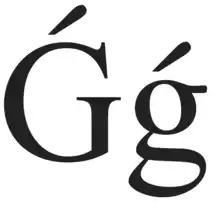| Ǵ | ǵ |

Doulos SIL glyphs for Majuscule and minuscule ǵ.
Ǵ, ǵ (G with acute accent) represents the Pashto letter geh (ږ), the Macedonian letter gje Ѓ[1] in Karakalpak, /ʁ/ (Cyrillic Ғ) and parts of Cantonese Yale Nǵ and Nǵh. The letter is also used to transcribe the Old Church Slavic letter djerv Ꙉ.[2]
The 2019 reformed alphabet[3] for Uzbek also contains this letter. It is currently represented by Gʻ.
In Kazakh, it was suggested to use it to replace the Cyrillic Ғ, but in 2019 the replacement suggestion was replaced by Ğ.
Computing code
| Preview | Ǵ | ǵ | ||
|---|---|---|---|---|
| Unicode name | LATIN CAPITAL LETTER G WITH ACUTE | LATIN SMALL LETTER G WITH ACUTE | ||
| Encodings | decimal | hex | dec | hex |
| Unicode | 500 | U+01F4 | 501 | U+01F5 |
| UTF-8 | 199 180 | C7 B4 | 199 181 | C7 B5 |
| Numeric character reference | Ǵ | Ǵ | ǵ | ǵ |
| Named character reference | ǵ | |||
See also
•Ѓ, its Cyrillic counterpart
References
- ↑ Jovanova-Grujovska, Elena (2017). Правопис на македонскиот јазик (PDF) (in Macedonian). Skopje. p. 179.
{{cite book}}: CS1 maint: location missing publisher (link) - ↑ Lunt, Horace (1974). Old Church Slavonic Grammar. The Hague: Mouton. p. 16.
- ↑ "Uzbekistan unveils its latest bash at Latin alphabet | Eurasianet". eurasianet.org. Retrieved 2021-11-22.
This article is issued from Wikipedia. The text is licensed under Creative Commons - Attribution - Sharealike. Additional terms may apply for the media files.